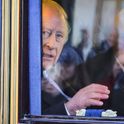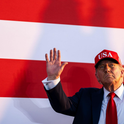The news from Afghanistan is rarely good. The Trump administration is reviewing its policy at a time when just 57 per cent of the country’s 407 districts are under government control and losses among Afghan forces in 2016 ran to an unsustainable total of 6,785. It seems that President Trump is minded to take military advice and demand a reinforcement of the Nato mission—expect a brisk exchange of views at the Nato summit on 25thMay.
Of course, this is not the only tension between America and a number of its allies, particularly those who spend less on defence than Nato’s requirement of 2 per cent of GDP. Of the 28 members, only the United States, UK, Greece, Estonia and Poland meet the funding commitment and the Americans have resorted to tough language to condemn the freeloaders. At the Munich Security Conference in February, US Defence Secretary James Mattis went so far as to suggest a “moderated commitment” to those in default and thus the possibility of a divisible Nato. Washington may pay passing attention to the shortcomings of Portugal, Bulgaria, Croatia and so on, but the real target is Germany.
Germany manages a multi-billion euro budget surplus yet spends only 1.2 per cent of GDP on defence. This rounds out to about €37bn; an increase to 2 per cent would take to around €67bn and transform the country’s role within Nato and possibly the world. In a post-Brexit Europe, this would restore Germany to a military predominance that would unbalance the Franco-German axis at the heart of the European Union and make Theresa May’s veiled threat of a withdrawal of British security co-operation rather empty.
But it won’t be easy. The ghosts of Germany’s past mean there is no consensus for change on this scale; the Social Democrats have already declared against any increase and the debate can only intensify in the run up to the autumn election. Nor is Germany structurally equipped for defence expansion on this scale. All defence expenditure over €25m needs to be ratified in parliament and the defence procurement office has had a hiring freeze for the last 10 years. But perhaps the post-war conventional wisdom that the burden of history will always limit German military capability needs to be re-examined.
There is a real asymmetry between cause and effect here. What in Washington looks like a simple matter of paying club subscriptions has the potential effect of reordering the European strategic landscape. There may be a change underway too in the way America views the role of Nato. The Alliance was founded on the concept of territorial defence, and, while expeditionary adventures in Afghanistan and elsewhere have broadened that role, it remains at heart a mutual defence pact. That sits uneasily with the Trump administration’s stated strategic priority of defeating radical Islamism.
Pulling the various strands together—differential relationships between individual Nato members, possible German pre-eminence in Europe and diverging strategic priorities—and it may be that the assumed inherent multilateralism of Nato begins to move in the direction of a series of bilateral deals with the US. This, of course, is exactly the way that America has designed its security architecture in East Asia: a series of bespoke deals with major actors like Japan and South Korea rather than an inclusive, collective alliance. It may also suit the temperament of a deal-making president.
But what about Afghanistan, will a few thousand additional troops make any difference? Improbably, they just might. President Obama despised military adventurism and placed every possible constraint upon it, including public declarations of a withdrawal timetable from Afghanistan. The Taliban, a military force that has been fighting since 1979, simply had to sit it out. President Trump seems to be playing it differently. Under the tutelage of his generals turned officials—Defence Secretary Jim Mattis and National Security Advisor H R McMaster—Trump appears willing to delegate operations to military control, make far more aggressive use of airpower and place US soldiers back on the battlefield.
Taken alone, those changes will have marginal effect and the Taliban may be tempted to sit it out again—but this time it may not be able to. The death by drone strike of Mullah Akhtar Mansour in 2016 deprived the Taliban of effective and unifying leadership. His replacement, Mawlawi Haibutullah Akhundzada, has proved inept and the movement may split. Losses have been crippling on the Taliban side too and its links with Pakistan has been increasingly targeted by US policy. When the warlord Gulbuddin Hekmatyar, dubbed “the butcher of Kabul,” reached an accommodation with the Afghan government last year, he showed that even the apparently irreconcilable could be brought inside the tent. It is just possible that a resolute west could push the Taliban in the same direction.
How will Trump affect Afghanistan and Nato?
His policies could shift Germany—and finally help topple the Taliban
May 16, 2017

United States President Donald J. Trump and Secretary General Jens Stoltenberg of NATO conduct a joint press conference in the East Room of the White House in Washington, DC, USA, on Wednesday, April 12, 2017 ©Sachs Ron/CNP/ABACA/ABACA/PA Images











